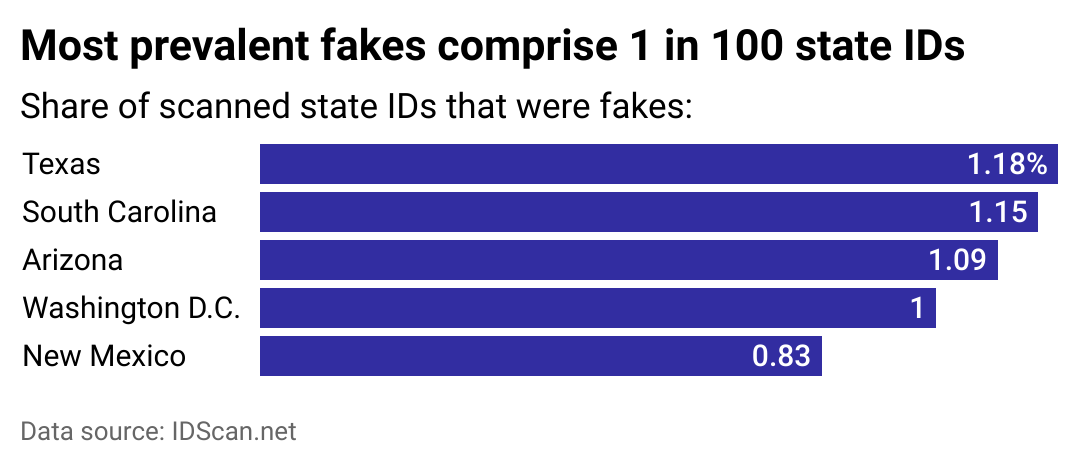Many young adults consider fake IDs a rite of passage. Nearly 2 in 5 students in their third year of college admitted to having a fake ID, and about 1 in 8 precollege students admit the same, according to a Psychology of Addictive Behaviors study published in 2007.
Almost two decades later since the study, the popularity of fake IDs hasn’t waned. Almost 7 in 10 Ohio State students said they have used or owned a falsified ID, according to an informal survey in 2021.
Recommended Videos
Not all fake IDs are created equal, but a sizable number are modeled on identification cards from the same few states. Spokeo used data from IDScan.net’s 2024 Fake ID Report to identify the five states with the highest prevalence of fake IDs in circulation. IDScan.net’s report is based on its scans of over 130 million physical IDs, with a minimum of 600,000 scans per state.
Fake ID usage peaks just before adults come of age to legally drink and consume cannabis. According to the report, fake IDs are most often spotted at cannabis dispensaries, with 64 out of 1,000 customers trying to pass off their IDs for the real deal, followed by alcohol and tobacco retailers at 49 out of 1,000 customers.
Though they may not be far from purchasing alcohol and cannabis legally, using fake IDs may indicate a greater appetite for risk-taking that often has major ramifications. College students with fake IDs are at higher risk of heavy drinking and alcohol-related arrests, as well as other substance use. Though the IDs themselves are not typically the cause of these behaviors, they do signal that some young adults may be falling into these habits earlier than they may have otherwise.
Creating, buying, possessing, or using a fake ID is considered a crime across the U.S. Penalties vary in different states; obtaining or using a fake ID is considered a misdemeanor across most of the country, though some states consider it a felony. The type of identification or how it is used can also elevate the level of the charge. Those convicted may have to pay fines, serve probation, or potentially spend time in jail.
What’s more, businesses caught providing underage individuals with alcohol—even unknowingly—face consequences. The establishments will likely be fined, and their liquor license may be suspended or revoked. Individual employees may also face criminal charges for serving minors, depending on the state and situation. Similar laws are in place for cannabis dispensaries.
To better understand the market for physical fake IDs, read on to learn more about the five states with the highest prevalence of forgeries created in their likeness.

Spokeo
The geography of fake IDs
People often opt to get fake IDs that look like they've been issued from another state. Each state has its own variations and designs, so when an ID looks less familiar to those checking them, people may be less likely to notice any variations or inaccuracies.
Among the states with the most prevalent fakes, more than 1 in 100 IDs in circulation were found to be fraudulent. Though the percentage seems low, consider the prevalence of fakes among the #1 ranked state was 20 times higher than the state with the lowest share of fakes in circulation, Massachusetts. Other states with few fake IDs were Iowa, Rhode Island, New Hampshire, and Missouri.
Fake IDs have evolved alongside ever-changing technologies. Today's fake IDs deploy special inks like hologram paint and sophisticated equipment to try passing common ID checks—visual inspections, barcode scans, and magstripe swipes.
Earlier this year, artificial intelligence-generated fake IDs made the news for quickly and cheaply creating images of fake IDs that can be used for online purposes, such as defying age-verification laws online or creating bank accounts to make cryptocurrency exchanges. While AI-generated images of fake IDs are currently specialized for online uses, they indicate an industry keeping pace with modern technologies.
Story editing by Carren Jao. Additional editing by Kelly Glass. Copy editing by Paris Close. Photo selection by Ania Antecka.
This story originally appeared on Spokeo and was produced and distributed in partnership with Stacker Studio.